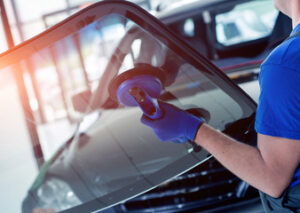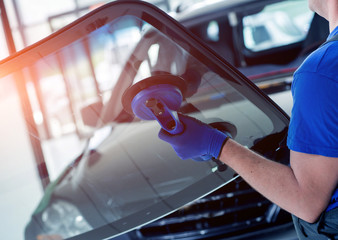A windshield is a large piece of glass that prevents wind, dirt, and debris from hitting your face. Unlike what you may think, your windshield is two sheets of glass pressed together.

Windshields Direct LLC doesn’t just provide you with a clear view of the road; it’s a key safety component. The two perfectly flat sheets of glass with a layer of plastic vinyl sandwiched between them keep you and your passengers safe from flying debris in an accident or collision. In addition, the windshield is designed to hold airbags in when deployed and help prevent water, bugs, dust, and ice from entering your vehicle.
During windshield installation, these sheets are bent to precise specifications to fit in the car frame and provide structural integrity in case of a crash or rollover. Polyurethane is the glue that bonds the windshield to the structure.
Your technician begins the replacement process by loosening the chrome or rubber trim around the edge of your car’s windshield with a razor blade. After this step, the technician will cut through any remaining urethane adhesive layers with a knife. Once this is done, your technician will forcefully push your old windshield out of the frame. That is one of the most dangerous parts of the entire windshield installation process. The brute strength required to make your old windshield out of the structure often causes it to crack. That is why it is important to find a shop with certified technicians who properly replace your windshield.
Before the new windshield is glued to the frame, your technician will prep the area where the urethane will be with glass prep. Then, they will spray the perimeter of the windshield frame and gasket with a lubricant. That will make it easier for your technician to slide the new windshield out of the frame later. If this step is skipped, it can cause your windshield to rust underneath the urethane, causing leaks, noise, and air whistles.
After the windshield is pushed into place and trimmed, your technician will tape it down. That holds it in place while the urethane cures. You should only remove the tape once your technician tells you so. Otherwise, the windshield may come loose while driving and cause you to lose sight of the road. It is also important to avoid going through a high-pressure car wash until your windshield is fully cured.
Laminated plastic (tempered or safety glass) is the most common type of windshield used in vehicles. It is sturdy and offers good resistance against shattering. It also can be tinted and has reflective coatings. It is less expensive than glass and offers similar impact protection, although it does not offer as much resistance against penetration by sharp objects. Other types of windshields include acrylic and plexiglass, which are cheaper but are less sturdy and may offer a different level of resistance against debris.
The preferred protective laminate films for automobile windshields have a flexible single-layer polymer substrate with a scratch-resistant coating bonded to a shock-absorbing adhesive. The shock-absorbing adhesive layer can comprise any cement, such as vinyl, polyurethanes, polyesters, or polycarbonates. The shock-absorbing material preferably has a Shore A hardness of at least 80. The overall protective laminate film must meet various minimum requirements, including flexibility (suitable for application to a curved windshield and storage on a roll), extensibility (100 to 600% elongation at break), low optical distortion, consistent refractive index, high transmittance (at least 97% of visible wavelengths), and chemical, water, and temperature resistance.
In one embodiment, a Teflon squeegee with a slip agent is applied to the surface positions of the protective laminate film. A generous amount of the slip agent is sprayed onto the windshield and on the exterior surface of the laminate film. The squeegee is then run over the laminate film to remove trapped air and lubricate the squeegee process. The slip agent will continue to act as a lubricant until the squeegee has fully bonded the laminate film to the windshield.
Alternatively, the protective laminate film may be pre-cut to the correct size for installation and then trimmed during windshield installation to prevent unnecessary material stretching. The windshield can then be cleaned to remove debris, and a lubricating solution can be sprayed on the glass. A heat gun can then be used to carefully apply heat to the windshield and start the shrinking process of the laminate film.
Polyurethane is the gold standard when it comes to car windshield bonding. It’s strong enough to keep the glass in place during a crash but also helps enhance passenger safety by ensuring the airbag deploys properly in the event of a rollover. That is why vehicle producers rely on Sikaflex(r) products that meet the demanding specifications of their customers.
Unlike traditional adhesives, polyurethane foams can be molded into different shapes and recover increased stress. They also have good insulation properties and are resistant to moisture, abrasion, and corrosion. Because of these properties, polyurethane is widely used in various applications, including construction, furniture, upholstery, and automotive components.
Urethane is a black, liquid-like glue that can be applied with a spatula. When used correctly, it will cure quickly and create a durable seal between the windshield and window frame, which is crucial to ensuring that your new glass stays in place during a crash.
Some types of auto glass don’t require urethane, such as windshields attached to mounts inside your door. However, the majority of glass in vehicles uses a urethane adhesive. That is because a urethane windshield has a pre-applied and cured urethane bead added by the glass manufacturer. This bead has a glossy black skin that prevents entanglement bonding with urethane molecules until it is removed or a special activator is applied.
The best urethane adhesives for auto glass have a high modulus, meaning they have less elongation than other adhesives. That is important because it allows the adhesive to flex with the vehicle’s body but remains rigid. This stiffness makes a windshield safe during a collision and improves vehicle handling and stability.
A quality urethane adhesive can be applied to the windshield with a paintbrush or foam roller, and it will dry within two hours at room temperature. Sikaflex UF-3010 is an advanced, warm-cure adhesive that can be applied to the windshield without setting blocks or dams. That makes it much faster than traditional methods, which can take up to two hours of extreme heat and humidity.
During a windshield replacement, the pinch weld is cleaned to ensure the new glass sits flush against it. The area also gets a bead of urethane applied around the perimeter to hold it in place. That is done with great care so that the urethane doesn’t drip on the bodywork, the new windshield, or the pinch weld, where it can be unsightly.
The area around the pinch weld is cleaned to remove dirt using a brush. That is important because any remaining material can interfere with the adhesion of the urethane to the windshield. In addition, this area can rust if it’s exposed to moisture.
A rusty pinch weld can be very dangerous to drive on because it will have weak spots where the metal folds over. Fortunately, this is easy to fix by simply filling in the affected area with a product designed for auto body parts. Once the repair is complete, it should be sanded and painted to match the rest of the vehicle’s finish.
Another common problem caused by a poor pinch weld is that the windshield can be installed too close to it. That can lead to the urethane adhesive bonding to the glass and breaking it when removed. So you can avoid this, the installer should always check that there’s more than 1/8″ of urethane on the pinch weld before installing the new windshield.
Sometimes, a technician may need to cut the urethane on the pinch weld. That is usually only required if a rock or other debris has damaged the windshield. In this case, the installer can choose to cut it from the inside or the outside of the car. When cutting from the inside, using an extended-handle razor knife with a repetitive dragging motion is important to avoid breaking the glass and making a mess. Choosing to cut from the outside can be difficult because if there’s less than an inch of urethane, the knife will not have enough room to drag it properly.

